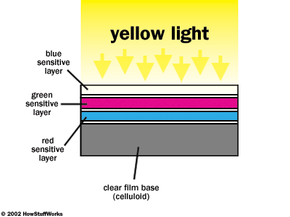Developing Film: Color
If your film were a color negative type (that gives you a print when returned from the photo processor), the processing chemistry is different in several major ways.
The development step uses reducing chemicals, and the exposed silver-halide grains develop to pure silver. Oxidized developer is produced in this reaction, and the oxidized developer reacts with chemicals called couplers in each of the image-forming layers. This reaction causes the couplers to form a color, and this color varies depending on how the silver-halide grains were spectrally sensitized. A different color-forming coupler is used in the red-, green- and blue-sensitive layers. The latent image in the different layers forms a different colored dye when the film is developed.
Advertisement
- Red-sensitive layers form a cyan-colored dye.
- Green-sensitive layers form a magenta-colored dye.
- Blue-sensitive layers form a yellow-colored dye.
The development process is stopped either by washing or with a stop bath. The unexposed silver-halide grains are removed using a fixing solution. The silver that was developed in the first step is removed by bleaching chemicals.
The negative image is then washed to remove as much of the chemicals and reaction products as possible. The film strips are then dried.
The resultant color negatives look very bizarre. First, unlike your black-and-white negative, it contains no silver. In addition to being a color opposite (negative), the negatives have a strange orange-yellow hue. They are a color negative in the sense that the more red exposure, the more cyan dye is formed. Cyan is a mix of blue and green (or white minus red). The overall orange hue is the result of masking dyes that help to correct imperfections in the overall color reproduction process. The green-sensitive image layers contain magenta dye, and the blue-sensitive image layers contain yellow dye.
The colors formed in the color negative film are based on the subtractive color formation system. The subtractive system uses one color (cyan, magenta or yellow) to control each primary color. The additive color system uses a combination of red, green, and blue to produce a color. Your television is an additive system. It uses small dots of red, green, and blue phosphor to reproduce a color. In a photograph, the colors are layered on top of each other, so a subtractive color reproduction system is required.
- Red is controlled by Cyan dye
- Green is controlled by Magenta dye
- Blue is controlled by Yellow dye
